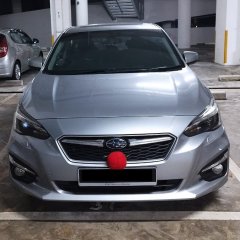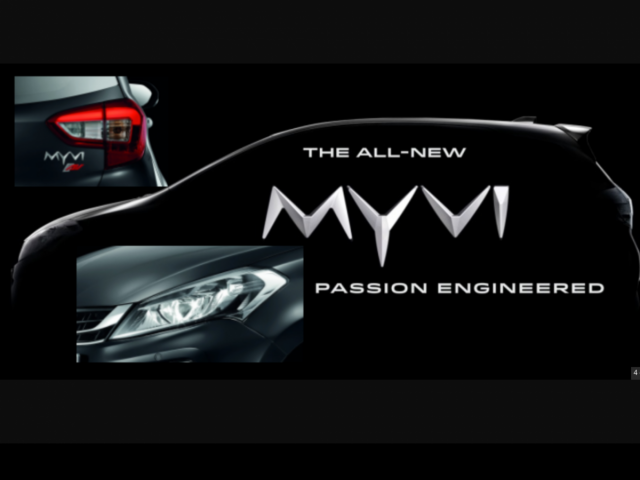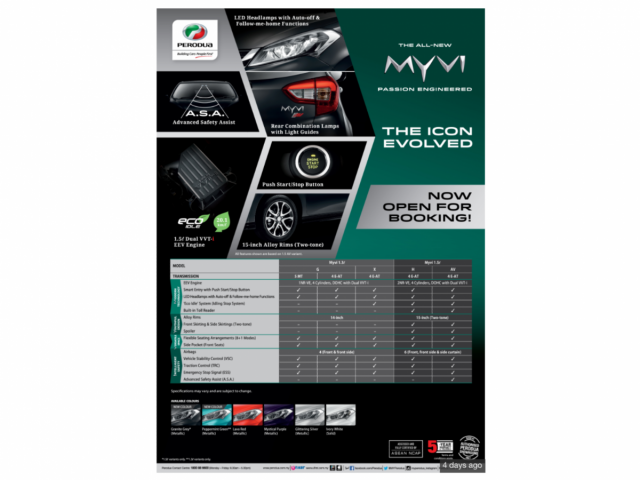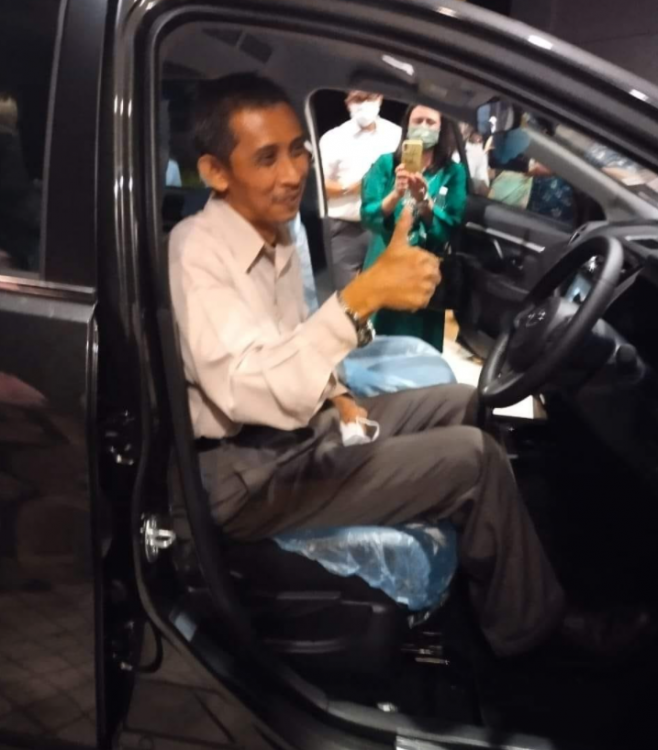Search the Community
Showing results for 'perodua' in topics.
-
Selling a 2017 Nissan Pulsar to buy a used 2016 Mini
metalstream replied to Bubble_tae's topic in General Car Discussion
That's the characteristics of a 3 cylinder engine - whether it's Mitsubishi Attrage, Nissan Note or Perodua Kelisa/Kenari. -
Launching soon. Anybody interested in getting this car? Come let us discuss..
-
https://www.sgcarmart.com/new_cars/newcars_overview.php?CarCode=12865 The long awaited suv from Perodua
- 203 replies
-
- 4
-

-
- aruz
- peroduaaruz
-
(and 1 more)
Tagged with:
-
Wow....less than $10K Singapore dollar? Malaysia really boleh...I don't mind driving one for marketing and simple outing when I retire there.... http://www.peroduaaxia.com/ http://www.mysinchew.com/node/100878 Perodua Axia opens for booking Friday 2014-08-14 13:04 KUALA LUMPUR, Aug 14 (Bernama) -- Axia, Malaysia's first energy-efficient vehicle (EEV) – with a tentative starting price of RM24,900 (for Peninsular Malaysia) - will be open for booking at all Perodua sales outlets from tomorrow, Perusahaan Otomobil Kedua Sdn Bhd (Perodua) said. In a statement, Perodua said the latest model is its most fuel efficient car that could travel up to 21.6 kilometers per litre, spacious, packed with unique Malaysian features, and boasted an overall low-cost ownership. Perodua President and Chief Executive Officer Datuk Aminar Rashid Salleh said the deal is the all-in-one package for every Malaysian. "The car will not only be able to fit four travel bags as it has a 260-litre boot capacity but also very flexible to ensure maximum comfort and usage," Aminar said. Slated to be launched soon, the Axia is Perodua's 10th model produced via Perodua's modern and ecologically-friendlier new manufacturing plant. "We believe that the Perodua Axia is competitive in the region, which explained why the word 'Asia' was incorporated into the name," he added. The Perodua Axia comes in four variants, namely Standard E, Standard G, Special Edition and Advance. It also comes with a five-year warranty – another first for Perodua. Booking fees are RM250 and RM300 - depending on the variant. In conjunction with the month of Syawal, Perodua is holding a nationwide open house at all its sales and service outlets on Aug 16 and 17 to usher in the festival and provide more information on the Perodua Axia to the public
- 128 replies
-
- perodua
- perodua axia
-
(and 2 more)
Tagged with:
-
Perodua better than Tesla
- 6,440 replies
-
- 1
-

-
- first pagers
- lai
-
(and 1 more)
Tagged with:
-
Yup. Vehicle pop control, usage control, in name of green, are just lip service. kaching kaching.....so much so. Buy a simple lousy Perodua Axia for oneself for some sense of ownership to go msia road trip also so cham...life indeed jin cham here even if one is willing to own a car but not contribute to jam..(kidding).
- 1,696 replies
-
- 1
-

-
https://paultan.org/2024/01/03/perodua-issues-statement-on-bezza-gula-viral-post/ "The gula, or sugar as mentioned in the customer’s Facebook post was in reference to a sugar-like foreign substance that was found in the engine of their vehicle, and that such substance resembling the foreign matter found is not used by Perodua, according to Perodua personnel as claimed by the vehicle owner." It seems like Perodua want to exchange damaged car with a new car. The problem could lie with Communication. The owner was told to apply for a new loan. Nobody tells her what will happen to her existing loan.
-
Perodua agrees to buy Nagakanni's Bezza at full price https://www.nst.com.my/news/nation/2024/01/997834/perodua-agrees-buy-nagakannis-bezza-full-price
-
Malaysian woman's new car breaks down after 8 hours; Perodua says sugar was found in engine https://www.asiaone.com/malaysia/malaysian-womans-new-car-breaks-down-after-8-hours-perodua-says-sugar-was-found-engine
-
MPVs and SUVs have been around for so long.....nothing to shoutabout.....u can see a lot of them q cutting when they drive thru custom.... Proton and Perodua...B&B car there, as a matter of fact a lot of B&B car from proton, toyota, honda and nissan.... if i stay there, i will just get a Perodua kelisa to drive around....
- 1,149 replies
-
- retirement
- malaysia
-
(and 3 more)
Tagged with:
-
Supposedly the replacement model of the ever popular JDM Toyota Rush / Daihatsu Be-Go. To be launched in Japan on 5 Nov. Quick Spec Dimension: 3,995mm (L) x 1,695mm (W) x 1,620mm (H) Engine: 1.0L Turbo Charged 3 Cylinder
- 112 replies
-
- 12
-

-
Chope parking lot for his i4 lah. I ask him to buy Ora Cat but he say too cheap for his blue propeller. It is a blessing for us, as we can never understand the pain of the rich, everyday have to crack their head on how to spend their money... @RH1667 Proton much more upmarket now (since under Geely). You should be worried there might be no more Perodua, since Daihatsu is in trouble now.
- 309 replies
-
- 12
-
.png)
-

-

Daihatsu admit tampering with safety tests for 30 years
Dafansu replied to Thaiyotakamli's topic in Japanese Talk
Perodua Axia, Toyota Agya & Daihatsu Ayla all same same. -

Daihatsu admit tampering with safety tests for 30 years
Watwheels replied to Thaiyotakamli's topic in Japanese Talk
Last time see a lot of Daihatsu running around should be the Terios or aka Toyota Rush. There is also the small hatchback named after a steak called Sirloin I mean Sirion. And also the Materia with a missing "L" at the back. Some of them still on our roads. Now Terios has evolved into the Perodua line up in Malaysia. -
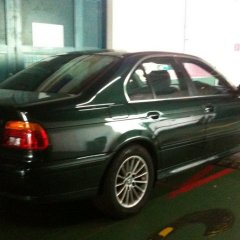
Daihatsu admit tampering with safety tests for 30 years
inlinesix replied to Thaiyotakamli's topic in Japanese Talk
Jialat liao. Not sure how many Vios here will be involved. The journalist never do homework. Toyota where got Toyota Perodua Axia -

Daihatsu admit tampering with safety tests for 30 years
Tommisan replied to Thaiyotakamli's topic in Japanese Talk
https://www.thedrive.com/news/daihatsu-tampered-with-safety-tests-for-88000-cars News published earlier in Apr 2023. Two named models, Toyota Yaris ATIV and and the Toyota Perodua Axia. -
Yes, of course they have been around for a long time. What we are saying is that the MPVs and SUVs are gaining traction over there with more and more sedan owners changing to those type of vehicles. And German makes are also a common sight thesedays. BTW, dun get a Kelisa la. Think that model no more. But the Myvis are good and decent. The Activa compact SUV with a 1.0L Turbo is also kind of cute and zippy for city driving. Many good Perodua options for you with just SGD$20k-SGD$25k , and probably still with some change.
- 1,149 replies
-
- 1
-

-
- retirement
- malaysia
-
(and 3 more)
Tagged with:
-
Important of Leadership and people mindset.. https://www.wapcar.my/news/40-years-ago-china-can’t-even-ckd-a-car-how-did-they-overtake-proton-and-perodua-31163 40 years ago China can’t even CKD a car, how did they overtake Proton and Perodua? Hans·Jul 26, 2021 02:07 PM When Proton was established in 1983, China didn’t even have a single modern car plant. By 1983, when Malaysia had become the first country outside of Germany to assemble a W126 Mercedes-Benz S-Class, China was still clobbering together ‘60s era Soviet sedans. We were once a rising Asian Tiger. At its peak in FY2010, Proton exported 22,000 cars (including CKD kits), not the highest but it was pretty decent for 100 percent Malaysia-developed products. Our technical competency was ahead of Thailand and Indonesia. Export of Proton cars to the UK, early '90s Today, Proton exports less than 2,000 cars annually. Meanwhile, Perodua exported 8,000 units in 2014. This has since dropped to just 2,825 cars in 2019. What happened to Malaysia's automotive industry? Perodua Myvi is exported to the Indonesia as a Sirion, but sales are limited by import quotas Also read: Why the Perodua Myvi continues to struggle in export markets? Meanwhile, China is now the world’s most important car market, selling over 25 million cars annually, and is the world’s capital of EVs. Once a technological backwater, China is now home to brands like Nio, which challenges the best EVs from BMW and Mercedes-Benz China's success was not supposed to happened, neither was Malaysia's decline Critics will say that comparison with China is unfair because of its huge domestic market, which grants it huge economies of scale. But that’s an overly simplistic view because India (1.38 billion population) is just as big but is still not yet an automotive powerhouse. Indonesia is the world's fourth most populous country, with over 270 million people but yet its Timor national car project failed. Remember that 10 million population Sweden is home to Volvo (Trucks), Scania, Volvo Cars, Koenigsegg, and SKF. Magna Steyr-made G-Class. Austria has a small population of just 9 million, but it does contract manufacturing for many legendary nameplates. Austria has a population of just 9 million but it is home to Magna Steyr, the world's most famous automotive contract manufacturer. Thanks to its many automotive engineering consultancies and specialist suppliers, it's hard to find a European car that doesn't have input from Austria. And don't forget that the 6 million population Singapore will be making Hyundai EVs soon. So while economies of scale is important, the world is too big and too complex for a binary yes/no, right/wrong view. Geely's Zeeker 001 is an EV styled like a Porsche Panamera Sport Turismo To say that China had it easy because of its huge domestic market also glosses over the fact that Chinese companies had to overcome hardships unimaginable by comfortable middle-class Malaysians. Remember that China endured what's known in history as the 'Century of Humiliation', facing one war after another, from being bullied by Western powers to legalize opium and cede control of its territories, to dealing with its many civil wars, it’s a miracle that China is still intact today. German, Japanese or Korean? It's Chinese. This is a Changan Uni-T. The company is owned by the Chongqing state government. When Volkswagen first set up business in China in the 1983, the same year Proton was established, VW found China to have no industrial base to support a modern automotive industry. STAC's Anting plant in 1983. Posth was shocked at the conditions - parts strewn everywhere, half-completed body shells left outside, broken windows allowed rain to enter VW executive board member Martin Posth, who was tasked to setup the first modern car factory in China, said in his memoir 1,000 Days in Shanghai, “The building had nothing in common with my understanding of a production facility.” Shanghai SH760A Posth was recounting his first visit to the state-owned Shanghai Automobile Tractor Corporation’s (precursor to today’s SAIC) plant in Anting, the site selected for VW to launch its entry into China. It was the ‘80s but the plant was still producing a Shanghai SH760A, a lightly modified ‘60s era Soviet sedan, using very rudimentary means. Chinese plants were using ropes and bamboo structures to manually move cars. Compared to China, Malaysian plants were like a sci-fi movie set. All photos taken in 1983 “I couldn’t for the life of me imagine the dilapidated factory producing even a single car that would come near being acceptable, based on our standards,” he added, questioning his bosses at Wolfsburg's rationale on working with the Chinese! China's rudimentary body shop before VW's entry vs Malaysia's highly automated facilities Malaysia, once the rising Asian Tiger Meanwhile, Malaysia has been making modern cars since 1967 – the Volvo 144S, the first country outside of Sweden to build Volvos. We know how to run car plants and make basic car parts – tyres, air filters, seats, instrument clusters, rubber parts, 12V batteries, windshields and windows, headlights, interior plastics etc. Swedish Motor Assemblers (now known as Volvo Car Manufacturing Malaysia) in 1967. Even until the '80s, Chinese car plants still couldn't match '60s Malaysia Our generally English-speaking work force makes it easy for foreign manufacturers to work with us and our economy was booming. Every major car producing nation had a vehicle assembly operation in Malaysia. CKD cars in Malaysia in 1981. There were nearly twice as many brands as today. From the British to the Americans, to the Japanese, Swedes, French, Italians, and German, everyone had local assembly operations here. If you were to go further back, the Australians (Holden) would be represented too. Only the Koreans were not on the list but that's because they haven't started exporting. Also read: Once poorer than Malaysia, how Korea’s car industry progressed further than ours? Even Dr. Carl Hahn, then Chairman of the Volkswagen Group and one of the most powerful figures in the automotive industry, saw it necessary to pay a visit to Malaysia. Foreign manufactures found it very easy to invest in Malaysia. Skilled workforce is plenty. Meanwhile, China had very few mechanics outside the military. We were not just good in manufacturing, Malaysians were running the entire end-to-end cycle of the car business, from financing to after-sales to marketing, and we were known to be among the best in Asia outside of Japan. Foreign manufacturers could trust skilled Malaysians to run the business. Yes, that's a very young Datuk Seri Ben Yeoh of Bermaz. This was in 1984, when he was with Daihatsu. The Germans at Daimler were so impressed with Cycle & Carriage that they gave the city of Ipoh, which had one of the highest concentration of Mercedes-Benzes for any city in the world (buoyed by the tin mining boom in the ‘50s), a giant logo to be put on top of the limestone hill at the city’s entrance. The now-closed down AMIM plant, Shah Alam Later, they returned to Malaysia to inspect the now defunct AMIM plant in Shah Alam, liked what they saw and moved heavens and mountains to allow Malaysia to become the first country outside of Germany to assemble an S-Class. The Italians noted City Motors’ marketing prowess. Buoyed by the tin mining boom, the Guilia and the Alfetta were the BMW 3 Series of the '60s and '70s. Malaysia was then one of Alfa Romeo's most important markets in Asia and the first country outside of Italy to use Alfa Romeo as police cars. PDRM's Alfa Romeo Alfetta. Credit: Alfista Malaysia In its heydays, Nissan saw Tan Chong as its most influential overseas distributor in Asia. Meanwhile in China, Posth said that the Chinese weren’t just starting from zero, but below zero. Machinery was lacking in China then. Modernization of VW's plant in China were done with manual labour. The only Chinese with a driver’s license were military personnel and nobody outside the military knew how to fix cars, never mind finding a local Chinese who knew anything about running a car company. VW Santana, the first modern car built in China, 11-April 1983. The first 100 units were made using imported German parts, as a trial to see if the Germans and Chinese could work together. The Shanghai-VW joint venture would only be formalized in 1985 “No matter what you touch, you lay your hands on a dozen of problems,” said Posth. From these extremely difficult beginnings, Posth would lay the foundation to make Volkswagen the No.1 brand in the world’s most important car market. The same year Shanghai-VW joint venture was formed, Malaysia was already making its own car. Today, Chinese brands are on their way to catchup with foreign rivals. They are not quite there yet, but are damn close. What was missing in Malaysia? Studying the development of China’s automotive industry against Malaysia’s, the biggest difference is not economies of scale (not relevant in ‘80s China), but the lack of meritocracy on our part. The early days of Proton and Perodua were left under the care of government-appointed bureaucrats who weren’t very good at looking after the interest of Malaysia. Proton entered a deal with Mitsubishi Motors, paying high royalties but could not export the Proton Saga without the approval of Mitsubishi, so much for being a national car. Hyundai too relied on Mitsubishi engines for their early models but faced no such export restrictions because this was the first and most important requirement for the Koreans. Hyundai made sure no such nonsense would happen. Also read: That one time when Proton and Dr. Mahathir were conned into a USA-export deal As for the first Perodua Kancil, it was based on an older generation Daihatsu Mira that was no longer produced in Japan. Japan had switched to fuel injection engines but Malaysia accepted a deal that involved closing off a portion of the market so Daihatsu could offload its old carburetor engines to Malaysia. From its first rollout in 1994 until it was discontinued in 2010, Perodua sold a shocking 725,870 units of the Kancil! One of the pre-conditions for the Volkswagen deal in China was that the car must be of current technology. The Santana (Passat B2) that VW gave China had just been launched in Germany one year earlier. The other pre-condition was that the joint venture must be funded with foreign currency, since China was too poor to afford more currency outflow. The game plan for the Chinese was quite simple – invite the foreigners, keep the partnership under tight Chinese control, keep the money within China. The last part was most crucial. Contract signing between STAC and VW in 1982 China was then too poor to be in any position of bargaining power but they pulled it off anyway. Explaining how they did it requires another post, but the short story is that while Shanghai officials were baiting Volkswagen, their peers in the neighbouring province of Jilin were baiting Toyota (via FAW). To get a better deal, Shanghai later opened talks with GM, which in 1997, offered SAIC the then-new Buick Century to China, while VW was still flogging its 14-year old Santana. Beijing was pitting VW against Toyota and GM to get a better deal for China. In contrast, Malaysia decided that it was a fair deal to block out foreign competition for Mitsubishi (and now Geely) and Daihatsu to profit from Malaysia uncontested. Whatever few cards the Chinese government had, they played it very well. Which brings us to another point about Chinese government officials. It’s not about market size or technology, it’s about humans The Chinese civil service model is quite different from the West. Instead, the Chinese civil works like a private company (ironic given it’s a communist background), where civil servants are graded based on their performance on economic growth of their region, job creation, and more recently, air quality – before they can be promoted (and sometimes, demoted). One cannot be appointed into a ministerial position until one has proven himself / herself at say, a mayor level. Chinese civil service structure. Credit: Eric Li, Ted Talk, A Tale of Two Political Systems Over in Malaysia, the position of a minister and chairman of GLCs are awarded based political patronage, not their qualifications. Remember Prasarana's gaffe? Consider the architect of China’s latest national automotive policy, Wan Gang, who until 2018, served as China’s Minister of Science and Technology. He is often credited as the person who made China the world’s capital for EV technology. Prior to working for the government, Wan was Tongji University’s professor of automotive engineering. He holds a doctorate from Germany’s Technical University of Clausthal, and before that, he was an engineer for Audi AG, serving as program manager for the B5-generation Audi A4. No permanent protection for China’s ‘national’ brands Another element of meritocracy in China is its treatment of local car manufacturers. Chinese manufacturers are protected from foreign competition by a 1994 rule that requires all foreigners looking to set up business in China to form joint ventures (JVs) with local manufacturers, with equity of the foreign company capped at 50 percent – it’s a way to protect local manufacturers, allowing them to quickly learn Western technology. In 2014, China's Ministry of Industry and Information Technology warned Chinese manufacturers that after 20 years, it is time to remove all protection. Chinese government will remove all protection for Chinese car manufacturers by 2022. By 2018, Beijing removed the equity cap for JVs for electrified vehicle. Soon, Tesla started plans to build a plant in Shanghai - the first 100% foreign-owned car plant. Chinese EV models will now have to compete directly with Tesla. By 2022, the equity cap will be abolished for all vehicle types. Not only that, import taxes on CBU cars have been slashed from 25 percent to 15 percent. This is inevitable as China needs to ease trade war tensions with USA and Europe. Turning the attention back to Malaysia, is Proton and Perodua stronger than when it started? From a domestic sales stand point, yes they are but when judged on merit, they made little progress in exports. Since two of our biggest brands don’t export much, our local parts suppliers are also not very competitive. According to the last manufacturing census done in 2015, only 167 out of 525 Malaysian parts manufacturers were engaged in exports. Malaysia has since lost 40% of foreign brands doing CKD Meanwhile, more foreign brands are pulling out from manufacturing in Malaysia. In the early ’80s, before Proton, Malaysia had 21 foreign brands with CKD operations here. Today, we only have 12, down by nearly half. Of course, the value of investments from the remaining manufacturers have also increased multiple folds but so have our neighbours Thailand and Indonesia. A child who lives off his parent’s money doesn’t get credit for growing taller right? Actually, the outcome of Malaysia’s national car and the eventual rise of China was evident from the moment the Proton-Mitsubishi Motors and Shanghai-VW partnership were established. Kenji Iwabuchi, standing next to Dr. Mahathir Despite enjoying generous government protection, Proton was losing money, mostly due to rapid increase in Yen value following the signing of the Plaza Accord by France, Germany, USA, UK, and Japan (but the Yen appreciation problem affects everyone equally). By 1988, 3 years after the Saga’s launch, Dr. Mahathir lost his patience and to keep the program going, he replaced the local management of Proton with Mitsubishi Motor’s Kenji Iwabuchi, and later Mitsuo Hattori - thus defeating the purpose of a national car. The then Finance Minister Daim Zainuddin reportedly expressed his disappointment with the local managers, saying “If that happens to a Japanese (losing money despite no competition), he commits hara-kiri.” (actually, the correct term is Seppuku). Meanwhile over in China, Posth’s German colleagues at Wolfsburg would often laugh at his Chinese project by asking him “How are your Chinese Micky Mice getting on?” Posth saw first-hand how fast Shanghai-VW's Anting plant was catching up with the West But Posth knew the inevitable outcome, that China will eventually surpass everyone else. Every German engineer who arrived in China to teach the locals were amazed at their eagerness to learn and catch up with the West. Xpeng P7 says, "Sorry, BMW i what?" “The Chinese understood anything that had to do with manual labour in next to no time. In the shortest time imaginable, they were assembling cars better and more quickly than anywhere else in the world – and this has not changed right up to the present day,” he noted in his book, but added to the journey ahead will be long and arduous. China wasn't the only automotive force that started way behind Malaysia. Korea too had a very difficult start. It emerged from the Korean War as one of the poorest countries in the world. This next post is a story of how Korea’s car industry overtook Malaysia's.
- 70 replies
-
- 13
-

-
hi all started this new thread for perodua owners in s'pore. can share tips on modi, spare parts n accessories, etc.
-
Seems like nobody started on the 2018 Perodua Myvi after searching through the folders . Perodua is going to launch the 2018 myvi (3rd generation)on 16/11/2017 The new car is slated to be vastly improved from its current model ,being outdated in terms of safety and specs. However, the new car is going to rectify all those flaws ,making the wrongs right. The car comes in the usual 1.3 and 1.5L engine guise and the tranny options are just a manual 5 speeder shifter or a dinosaur age 4 speed self shifter(yawn) Features in the 1.3L guise 1.3L Dual VVT-i four cylinder (94bhp/121Nm) 1.3L Standard G (Malaysian spec) Four speed auto or five speed manual LED headlamps (auto on/off, follow me home function) Headlight leveling LED tail lamps with LED light guides Reverse sensors 14 inch alloy wheels Keyless entry and push button ignition 8+1 seat configuration 60 : 40 folding rear seats Side pockets on the front seats (mobile phone usage only) Four airbags ABS, EBD, VSC, Traction Control, Emergency Stop Signal (ESS) Five year or 150,000km warranty 1.3L Premium X (Malaysian spec) Four speed auto only LED headlamps (auto on/off, follow me home function) Headlight leveling LED tail lamps with LED light guides Reverse sensors 14 inch alloy wheels Keyless entry and push button ignition 8+1 seat configuration 60 : 40 folding rear seats Side pockets on the front seats (mobile phone usage only) Four airbags ABS, EBD, VSC, Traction Control, Emergency Stop Signal (ESS) Five year or 150,000km warranty Eco-idle stop/start system Other exterior trim (Unconfirmed) Features in the 1.5L guise 1.5L Dual VVT-i four cylinder (106bhp/140Nm) 1.5L High (Malaysian spec) Four speed auto only LED headlamps (auto on/off, follow me home function) Headlight leveling LED tail lamps with LED light guides Reverse sensors 15 inch dual-tone alloy wheels Keyless entry and push button ignition 8+1 seat configuration 60 : 40 folding rear seats Side pockets on the front seats (mobile phone usage only) ABS, EBD, VSC, Traction Control, Emergency Stop Signal (ESS) Five year or 150,000km warranty Eco-idle stop/start system Other exterior trim (Unconfirmed) Front bodykit and side skirts in a dual-tone finish Two tone rear bumper Rear spoiler Built-in toll reader (Integrated SmartTag) Six airbags 1.5L Advance (Malaysian spec) Four speed auto only LED headlamps (auto on/off, follow me home function) Headlight leveling LED tail lamps with LED light guides Reverse sensors 15 inch dual-tone alloy wheels Keyless entry and push button ignition 8+1 seat configuration 60 : 40 folding rear seats Side pockets on the front seats (mobile phone usage only) ABS, EBD, VSC, Traction Control, Emergency Stop Signal (ESS) Five year or 150,000km warranty Eco-idle stop/start system Other exterior trim (Unconfirmed) Front bodykit and side skirts in a dual-tone finish Two tone rear bumper Rear spoiler Built-in toll reader (Integrated SmartTag) Six airbags Advanced Safety Assist (ASA) Pre-collision warning (PCW) Pre-collision braking (PCB) (Low speed autonomous braking) Front Departure Alert (FDA) Pedal Misoperation Control (PMC) Price in Malaysia ranges from RM 44,300 to RM 55,300 Colours available:Ivory White, Glittering Silver, Mystical Purple and Lava Red,Peppermint Green (1.3 only), Granite Gray(1.5 only) For what I think, this car, if it were to be imported, would be a force to reckoned with as it is so value for money that in the high spec guise, shames the Mitsubishi Space Star other than its brand name. If there is anything to add in after which, I will add in here. Moderators, if you all feel that there should not be a all new Myvi thread for the all new Myvi 2018, please kindly transfer it to an old topic. Thanks. Information from :https://paultan.org/2017/11/08/new-2018-perodua-myvi-details-1-31-5-dual-vvt-i-46-airbags-vsc-asa-with-aeb-rm44300-rm55300/new-perodua-myvi-teasers-16/
-
source: https://paultan.org/2021/02/22/perodua-ativa-suv-1kr-vet-1-0l-3cyl-turbo-deep-dive/ Perodua’s long-awaited compact SUV, the Ativa, is the talk of the town. Based on the attractive Daihatsu Rocky/Toyota Raize and utilising more of its Japanese partner’s technology than ever before, the D55L promises to be the most advanced Perodua ever – marking a new era for the national carmaker. So far, we’ve looked at the specs, name and pricing; here, we’re taking a deep dive into the Ativa’s new engine, the 1KR-VET. Utilising just three cylinders and 1.0 litres in displacement, it will mark Perodua’s first foray into the world of turbocharging, making it bang up to date with the industry trend of downsizing. As the name suggests, the 1KR-VET is part of Toyota’s KR engine family, which also includes the 1KR-VE naturally-aspirated mill found in the Bezza and Axia. The lineup shares the same aluminium block, cylinder count and 71 mm cylinder bore, but the unit in the Ativa will have a scant 0.1 mm shorter piston stroke than the rest at 83.9 mm. This knocks two cubic centimetres off the displacement, dropping it down to 996 cc. The engine’s stroke has likely been shortened to reduce the compression ratio, which has fallen from 11.5:1 on the Bezza and Axia to 9.5:1. This facilitates the addition of the already-compressed air from the turbo, which would otherwise cause knocking. As is typical for a simple turbo engine, the Ativa will feature a single-scroll turbocharger and a front-mounted intercooler. To keep costs down, it will get regular multi-point injection rather than the more expensive direct injection technology; it will also retain the Bezza/Axia’s variable intake valve timing, double overhead cams, timing chain and four valves per cylinder (12 in total). Naturally, with a turbo in place, the 1KR-VET is significantly more muscular than the 1KR-VE, with outputs of 98 PS at 6,000 rpm and 140 Nm of torque from 2,400 to 4,000 rpm. Against the Bezza and Axia, the Ativa will have an advantage of 30 PS and nearly 50 Nm, which is not to be sniffed at. Those figures are also not a world away from the Nissan Almera, which has a similar 1.0 litre turbo triple and CVT configuration. To enhance the sensation of speed, the Rocky and Raize get a Power button on the steering wheel, which remaps the engine and gearbox for quicker throttle response; it’s unclear, however, if the Perodua version will come with the same function. But the turbo isn’t just good for power – Perodua is claiming an impressive fuel consumption figure 18.9 km per litre for the Ativa. That’s even better than the Daihatsu and Toyota’s 18.6 km per litre with front-wheel drive, although that number was achieved on the stricter WLTP cycle. The downsized engine and stepless transmission go some way towards improving efficiency, but the Rocky and Raize also benefit from a start-stop system. The Bezza and Myvi already come with this feature, but the one in the Daihatsu and Toyota has been improved slightly, switching the engine off when decelerating from 9 km/h (up from 7 km/h). Looking at the technologies, output figures and efficiency numbers on offer, we’re pretty sure most of you can’t wait to try out the Ativa for yourselves (and we can’t, either!). But what do you think – is turbocharging the right path for Perodua, or would you have preferred it to stick with a more conventional naturally-aspirated engine? Sound off in the comments after the jump.
-
https://waupost.com/msian-students-pool-money-together-to-buy-their-beloved-teacher-a-rm70000-car-for-his-retirement/ must have been extremely well-liked to have received such a lavish gift by students from 38 spm batches spannin 1980 to 2021 Paid off in full too In sg context the aruz will set u back by at least 100k but maybe u have to buy ur own coe 😅 Good gesture
- 18 replies
-
- 12
-

-

-
.png)
-

Tesla earns 5 times more per car than Toyota, earnings show
inlinesix replied to steveluv's topic in General Car Discussion
The only successful auto company in Malaysia (or Asean) is Perodua. Their R&D staff is embedded into Daihatsu team. Raize/Rocky/Rex/Ativa has input from Perodua R&D staff. Toyota Agya/Perodua Alza is another collaboration btw Perodua and Toyota. -
Also everyday thousands of Perodua Myvi driving along there no issues at all.😁
- 6,440 replies
-
- 2
-
.png)
-
- first pagers
- lai
-
(and 1 more)
Tagged with:
-
This is NOT the 1st Generation Daihatsu Terios nor Toyota Cami (JDM)... Look at the badge, it is neither the Perodua Kembara... This is a copy cat by Zotye, and you guess it, from China. Even the interior is largely the same as Daihatsu, Toyota and Perodua...






